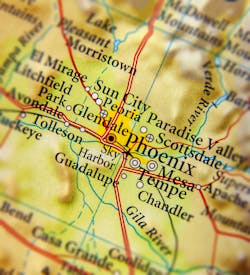Phoenix Drought Pipeline Program: Less Resources, No Problem
Submission by Mary Jo Finchum of Stanley Consultants
Edited by Mandy Crispin
The City of Phoenix Water Services Department (WSD) has a long history of diversifying its water supply and planning for the future. As a result, the City began planning for drought resiliency years before restrictions began on the Colorado River. Based on a 2017 study, it was found that there would be a water supply shortage to 400,000 residents in north Phoenix if there was an outage of the Central Arizona Project (CAP) supply.
The study analyzed alternatives to sustain a projected demand shortage during an outage of the CAP requiring major upgrades to the City’s water delivery infrastructure. It revealed the need for additional water supply in north Phoenix being served by two CAP water treatment plants (WTP). Major upgrades to the system were recommended to provide resiliency, redundancy and flexibility to ensure a safe and reliable water supply for customers throughout Phoenix.
The city’s primary goal was to ensure that customers in north Phoenix would continue to have water service if there are restrictions on the Colorado River, while providing operations staff with flexibility, and redundancy within the Phoenix water system.
This goal was accomplished by creating the infrastructure to move water from the Salt River Project system northward to the Central Arizona Project service area. The improvements help to ensure reliable delivery of water to northern parts of Phoenix during periods of drought and possible reduced availability of Central Arizona Project (CAP) water supplies. It is the largest capital improvement project that Phoenix Water has funded.
The Zone 3D and 4A Improvements Program (Program), also known as the Drought Pipeline Program, was chartered for nearly $300 million in improvements to ensure this reliable water supply. The Program provides water supply to 400,000 residents of the City of Phoenix and includes three new 30-90 million gallon per day booster pump stations (BPS) and an upgrade to a fourth BPS; two new pressure-reducing valve stations; 12 miles of new 66-inch pipeline; and an upgrade of 1 mile of existing 36-inch pipeline to 42-inch.
The program was divided into seven packages, each assigned an engineer and construction manager at risk, all under a single program manager. It allowed for pre-design planning to set the foundation for design and construction, development of standards and procedures to create consistency, improve quality, mitigate risk and keep stakeholders informed. In addition to providing water during restrictions on the CAP system, the Program had to be operationally flexible, meet budgets, maintain quality and consistency between projects and keep stakeholders informed throughout the duration.
- Based on funding and timing, four ‘core’ projects became the critical path for completion, set for December 31, 2022:
- Segment 1: 66-inch diameter welded steel water transmission pipeline from the 24th Street WTP to Shea Boulevard/32nd Street
- Segment 2: 66-inch diameter welded steel water transmission pipeline from Shea Boulevard/32nd Street to Bell Road/32nd Street
- Package 1: BPS 4A-B10 (63 million gallons per day (mgd) capacity with future 90 mgd) and 60 mgd PRV 1-R8 at the 24th Street WTP
- Package 4: BPS 4A-B11 (64 mgd capacity with future 90 mgd) at 31st Street and Bell Road
The construction of new pipelines allowed the City to remove aging asbestos cement pipe and replace it with new ductile iron pipe. A total of 5,000 feet was removed and replaced and over 2,500 feet of asbestos cement communications duct bank conduit was removed to provide an open corridor for the new 66-inch pipe.
Connecting new booster pump station to the plant’s existing weir box necessitated the installation of 72” steel pipe through a web of existing infrastructure at the City’s 24th Street Water Treatment Plant. Numerous buried utilities, a roadway and various structures had to be carefully navigated. An extensive investigation and 3D modeling of the obstacles, bore tunnel and bore pits was completed to ensure that costs and impacts to plant operations were minimized.
The overall scope and complexity of the Program led to numerous complexities that were resolved through innovative planning, design and construction.
Construction began in early 2021 as high demand in materials and supply chain shortages began. This shortage inspired one contractor to take control of its backfill material production by using two mixer trucks to produce over 42,000 cubic yards of Controlled Low Strength Material (CLSM). The self-batching process allowed for rapid backfilling deep trenches, which minimized safety hazards to the traveling public and enabled access to neighboring businesses.
A portion of the pipeline constructed in the Phoenix Mountains Preserve (PMP) provided the opportunity to upgrade portions with new walking paths, trail improvements and new art wall installations. A new masonry block wall on Maryland Ave. provides public art and additional security and safety to the 24th Street WTP. The second wall was installed on the Perl Charles Trail.
In order to tighten the hundreds of bolts one contractor used a battery-operated torque gun with digital torque settings from 300-1,500 ft. lbs. The torque gun was much safter to use than other traditional means of using torque wrenches or pneumatic Hy-Torq systems and could torque up to 400 fasteners on a single battery charge.
Using open cutting methods across each intersection or large utility along the 12 miles of new 66-inch pipeline would have created significant negative impacts to the traveling public. Instead, the jack and bore operations were used within these segments. Pile shored excavations were required in some locations and others used hand-digging tunneling methods due to extensive critical underground utility infrastructure and existing hard soil conditions. Underground tunneling with sizes up to 96-inches prevented shutdowns of six major intersections and prevented interruptions caused by utility strikes. The program also included a 340-foot-long tunnel under State Route 51.
